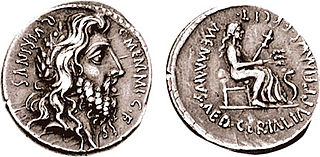Top Qs
Timeline
Chat
Perspective
Memmia gens
Families in ancient Rome who shared the Memmius nomen From Wikipedia, the free encyclopedia
Remove ads
The gens Memmia was a plebeian family at ancient Rome. The first member of the gens to achieve prominence was Gaius Memmius Gallus, praetor in 172 BC. From the period of the Jugurthine War to the age of Augustus they contributed numerous tribunes to the Republic.[2]


Remove ads
Origin
The poet Vergil linked the family of the Memmii with the Trojan hero Mnestheus. This late tradition suggests that by the end of the Republic, the gens had become a conspicuous part of the Roman nobility.[2] The nomen Memmius is classified by Chase with those gentilicia that either originated at Rome, or cannot be shown to have come from anywhere else. From its morphology, the name could be derived from a cognomen, Memmus, the significance of which is unknown.[3] The use of Quirinus, a Sabine deity, on the denarii of Gaius Memmius in 56 BC, perhaps alludes to a Sabine origin of the gens.[4]
Remove ads
Praenomina
The main praenomina of the Memmii were Gaius, Lucius, Quintus, and Publius. There is also at least one example of Titus.
Branches and cognomina
The Memmii of the Republic did not possess hereditary surnames, but two distinct families are identifiable by their respective voting tribes, the Galeria and the Menenia.[5] They did nevertheless use a number of personal cognomina, including Quirinus, thought to have been the name of a Sabine god, who came to be equated with both Janus and Romulus; Gallus, referring to a cockerel, or perhaps to a Gaul; and Geminus, traditionally given to a twin.[6] Other cognomina are found in imperial times, including Maximus, given to an eldest brother, or someone particularly notable; Regulus, a diminutive of rex, a king, used by a number of old Roman families; Pollio, a polisher, particularly of armour; Afer, referring to the province of Africa; and Senecio, a diminutive of senex, an old man.[7][8]
Members

- This list includes abbreviated praenomina. For an explanation of this practice, see filiation.
- Gaius Memmius C. f. Quirinus, plebeian aedile prior to 210 BC, was the first to exhibit the Cerealia at Rome.[9][10]
- Gaius Memmius Gallus, praetor in 172 BC, obtained Sicily as his province.[11][9][12]
- Titus Memmius, commissioner sent by the senate to hear the complaints of the Achaeans and Macedonians against the Roman magistrates, in 170 BC.[13][14]
- Quintus Memmius, legate sent by the senate to the Jews circa 164 BC.[9][15][16]
- Lucius Memmius C. f., a senator in 129 BC, perhaps the son of Gaius Memmius, the praetor of 172. He was probably the senator who visited Egypt in 112 BC.[17][18][19]
- Gaius Memmius, nicknamed Mordax, was tribune of the plebs in 111 BC. A candidate in 100 for the consulship, he was bludgeoned to death by the supporters of Saturninus and Glaucia.[9][20][21][22][23][24][25][26]
- Lucius Memmius, triumvir monetalis circa 109 BC, brother of Gaius Memmius, the tribune of the plebs of 111. Cicero describes them as mediocre but aggressive orators. He was also a supporter of Marcus Livius Drusus and his daughter married Gaius Scribonius Curio, the consul of 76.[27][28][29][30]
- Memmia L. f., wife of Gaius Scribonius Curio.
- Lucius Memmius, triumvir monetalis in 106 BC, pictured Venus on his denarii, an allusion to the gens' claim of Trojan descent.[i][9][1]
- Gaius Memmius L. f., triumvir monetalis in 87 BC, together with his brother, Lucius.[ii][31]
- Lucius Memmius L. f., triumvir monetalis in 87 BC, together with his brother, Gaius.[31]
- Gaius Memmius (C. f.), married a sister of Gnaeus Pompeius, under whom he served in Sicily in 81 BC, and later in Hispania, where he died in 75. He was probably the son of Gaius Memmius, the tribune of 111.[9][32][33][34][35]
- Publius Memmius, a witness for the defense at the trial of Aulus Caecina in 69 BC.[9][36]
- Gaius Memmius L. f. Geminus, son of Lucius Memmius, the triumvir monetalis of 109 BC, was an eloquent speaker and poet. He was tribune of the plebs in 66 BC, praetor in 58, and propraetor in Bithynia and Pontus the following year. He was the first husband of Fausta Cornelia, the daughter of Sulla.[9][37][35]
- Gaius Memmius C. f. L. n., triumvir monetalis in 56 BC, tribune of the plebs in 54 BC, prosecuted various officials for corruption; he was consul suffectus in 34 BC, and exhibited games in honour of Venus Genetrix.[9][38][39][40][41][35][4]
- Lucius Memmius C. f. L. n., of the tribe Galeria, a tribune of the plebs at an uncertain date, distributed lands to the veterans of the 7th and 26th legions in 41 BC.[42][43]
- Publius Memmius P. f. Regulus, consul suffectus ex Kal. Oct. in AD 31, and subsequently governor of Macedonia, was the first husband of Lollia Paulina, afterwards the empress of Caligula, who compelled them to divorce so that he could marry her.[9][44][45][46][47]
- Lucius Memmius Pollio,[iii] consul suffectus in AD 49.[9][48][49]
- Gaius Memmius Regulus, probably the son of Publius Regulus, was consul in AD 63.[9][50][51][52][47]
- Senecio Memmius Afer, consul suffectus in AD 99.
- Lucius Memmius Tuscillus Senecio, son of the consul of AD 99.[53]
- Memmius Vitrasius Orfitus, praefectus urbi from 353 to 355, and 357 to 359.[54]
- Quintus Aurelius Memmius Symmachus, consul in AD 485.
Remove ads
See also
Footnotes
- The legend GAL on his coins refers to his tribe, Galeria, and is not a cognomen; he used it to distinguish himself from Lucius Memmius, the moneyer of 109.
- Evidently the sons of Lucius Memmius, the moneyer of 106, since they reused the design of his coins, as well as mentioning the tribus Galeria.
- Or possibly Mammius.
References
Bibliography
Wikiwand - on
Seamless Wikipedia browsing. On steroids.
Remove ads
